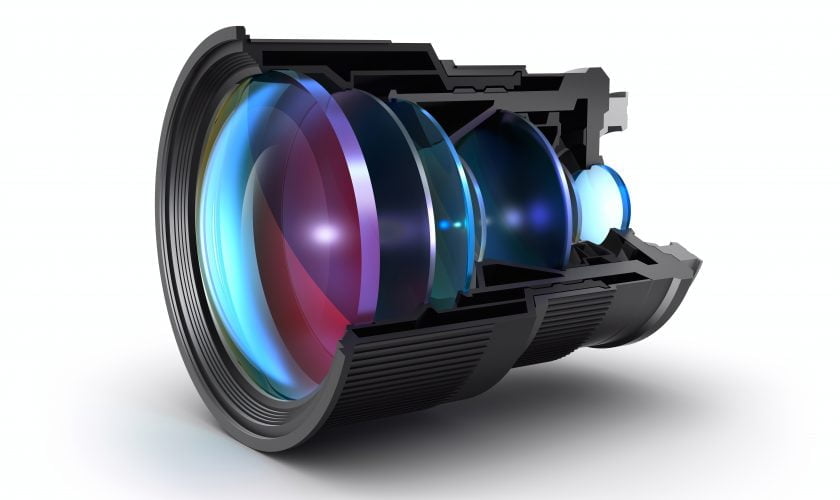Basics of Aperture
01. Aperture definition
Aperture is an optical hole formed by overlapping metal sheets (Di 5 to 9 pieces) inside the lens. The amount of light received by the image sensor can be adjusted by adjusting its opening and closing degree.
The larger the aperture, the more light entering; The smaller the aperture, the less light.
The aperture size is represented by numbers. The larger the number is, the smaller the aperture is, that is, the less light enters.

02. Aperture coefficient
Aperture coefficient is called “f coefficient” for short.
Popular f coefficient markers are: f1, 1.4, 2, 2.8, 4, 5.6, 8, 11, 16, 22, 32, 45, 64.
The f coefficient of a camera lens usually has only seven to eight consecutive ranges. Per esempio, f2~16, f1.4~16, f2.8~22, f5.6~f45, eccetera.
The f factor is calculated according to the formula: f=lens focal length/optical hole diameter
Therefore, for lenses with the same focal length, the smaller the number of f coefficients, the larger the optical aperture; The larger the number, the smaller the aperture. If the optical aperture of f2 is larger than f4, the optical aperture of f8 is smaller than f5.6.
03. Function of aperture
The role of aperture in photography practice can be summarized as follows:
- Adjust the incoming light intensity – this is the basic function of the aperture. Adjust the aperture to increase the incoming light intensity; Turn down the aperture to reduce the incoming light intensity. The combination of the shutter speed and the utility model solves the need of exposure;
- Adjust the depth of field effect – this is an important role of aperture. Large aperture, small depth of field; Small aperture, large depth of field. The control of depth of field is one of the important technical means of photography;
- Impact on imaging quality – this is the role of aperture that is easily ignored. The imaging quality of any camera lens with a certain aperture is the best, that is, it is least affected by various aberrations. This aperture is commonly known as the “best aperture”. The accurate position of the “best aperture” can be measured with special instruments. In generale, the best aperture is around f8. When the aperture is larger than the optimum aperture, the spherical aberration and coma gradually increase; When the aperture is smaller than the optimum aperture, the diffraction gradually increases.
04. Aperture adjustment
When adjusting the aperture of some cameras, they can have a clear positioning feel whenever they are adjusted to a certain f-factor (some cameras also include being adjusted to the middle position between two gears). This aperture is called stagnation aperture, and the one without this positioning feel is called non stagnation aperture.
Al contrario, the stagnant type is better, which means that when shooting in dim light, you can adjust the aperture by hand without visual observation.
When adjusting the aperture, it is advisable to adjust it slowly step by step, not too fast or too fast, otherwise it may cause the f-factor to be inconsistent with the actual aperture size. Aperture can be adjusted at any position between two gears to indicate the corresponding aperture size. If it is set between f8 and f11, it means that it is half gear lower than f8 and half gear higher than f11.
05. Preset automatic aperture
Preset automatic aperture refers to the design of an aperture structure. It means that when you adjust the f-factor of the aperture on the aperture adjustment ring of the camera, no matter what aperture factor you adjust. The aperture is always in the state of maximum aperture. Only when the shutter button is pressed to release the shutter, the aperture automatically shrinks to the size of the optical aperture with the set f-factor, and the aperture returns to the maximum aperture after exposure.
Single lens reflex cameras basically adopt preset aperture design to improve the brightness of the viewfinder screen: it should be noted that this “preset automatic aperture” is different from the “aperture automatic” in the camera’s automatic exposure mode.
The above is all about the basic knowledge of lens aperture, for reference.
Shenzhen Jinshikang Technology Co., Ltd. has devoted many years to the field of camera modules, specialized in the research and development and design of camera modules, and has invested a lot of development and research work in face recognition technology, camera monitoring and other fields, Together with the brother company Shenzhen Jinchengtai Electronic Technology Co., Ltd.
(professional lens production dust-free workshop, high-performance optical production equipment, più di 200 production staff, specializing in the production of various camera module supporting lens equipment), we will create a complete camera module+optical lens production industry chain. It has a perfect and standard business consultation process, allowing you to achieve smooth and satisfactory whole process from consultation to cooperation, and ensuring product quality and after-sales clearance.
Basics of Aperture Basics of Aperture Basics of Aperture Basics of Aperture Basics of Aperture Basics of Aperture Basics of Aperture Basics of Aperture
